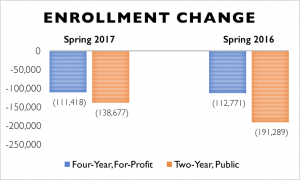The National Student Clearinghouse’s enrollment data is out, and the big headline is that enrollments are down—yet again. But a closer look reveals a few more interesting trends about the sorts of players struggling and succeeding across the industry. Students are voting with their feet, and here’s what they’re saying:
For-profits are on the decline—but do we understand why?
For-profit schools continued to bleed students—over 100,000 fewer students were enrolled in Spring 2017 than Spring 2016, a 10 percent decline across the sector. We also know from recently released NCES data that this is in part because for-profit schools are closing at a fast clip. The number of for-profit institutions declined from a peak of 3,452 in 2012 to only 2,285 Title IV eligible for-profit schools in 2016. For-profit schools are struggling with a reputational crisis, following several high profile school closures and an increase in regulation under the Obama administration.
Students are leaving for-profit schools—but where are they going?

One place to look might be community colleges. But the data doesn’t bear it out. Rather than seeing an influx in enrollments, community colleges in fact saw their enrollments drop as well—and by raw numbers, they are bleeding students faster than for-profit schools
These numbers suggest that the for-profit sector’s troubles may go beyond those of its own making. It’s likely that a good economy is convincing workers to keep working. Higher education enrollments of adult learners (students over 24 years old) have been contracting at about 3.5 percent annually. Wage increases have been above 2 percent since 2015, and the economy has added almost 2.5 million jobs a year over the past five years. If the economy keeps chugging along, for-profit schools and community colleges are likely to continue to see headcounts decline.
But when wage growth or job growth slows down, we should expect to see more workers heading back to school in search of better opportunities—the question is, where will they enroll? Current data suggests that students may be turning to a different sort of institution.
Innovative programs are the bright spots in higher ed
Enrollment in higher education declined by 1.5 percent overall. This was felt across the country—38 states saw enrollments drop. But three states bucked this trend and saw the biggest gains in 2017: Arizona, New Hampshire, and Utah. Interestingly, these states also saw the biggest enrollment gains in 2016 as well. Why?
In each case, the vast majority of the growth can be attributed to one institution in the state: Arizona State University, in Arizona; Southern New Hampshire University in New Hampshire, and Western Governor’s University in Utah.
Arizona State University is ranked by US News & World Report as the most innovative school in the country, and has not only worked to broaden enrollment, but also to improve its research capabilities and academic quality. ASU has built an online program, called Skysong, which has driven a large part of ASU’s growth, along with other programs like Global Freshman Academy and a partnership with Starbucks.
Southern New Hampshire University likewise is growing in leaps and bounds, as a result of major investments in online education. SNHU has also invested in competency-based education through a program called College for America. By focusing in on the jobs to be done of adult learners, SNHU has been able to build programs with a distinctive appeal to students who are hoping to advance their education mid-career.
Utah-based Western Governors University, which now has students in all 50 states, has seen steady growth in enrollment, increasingly driven by referrals from students and alumni. WGU’s competency based programs turn out many of America’s teachers, nurses and tech workers. Despite not having raised tuition since 2008, WGU (along with SNHU) now has one of the ten largest university enrollments in the country.
Innovation isn’t just a buzzword—these programs are actually helping students get college degrees and make progress in their lives. And students are recognizing the value of these programs. Even a market where many potential students are choosing t0 stay in the workforce, driving enrollment declines across higher education, these programs are seeing big gains.
Where are we heading?
While countless taskforces, think tanks, conferences, and committees debate the future of higher education, enrollment is the bellwether of the industry. It currently shows two things. First, a good economy is keeping students in the workforce and out of school, hitting enrollment at community colleges and for-profit schools. But second, despite a strong economy, there are still many workers looking to reskill or upskill for a turbulent economy. A disproportionate number of them are choosing to do so at highly innovative programs, creating a few bright spots in an otherwise gray enrollment landscape.


